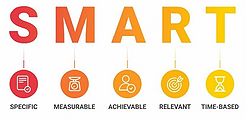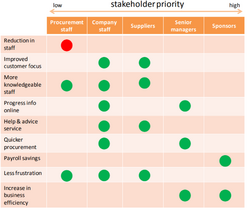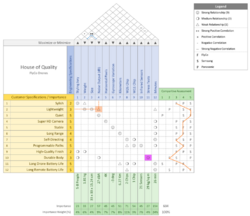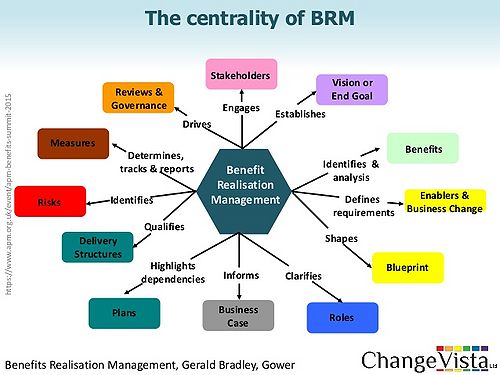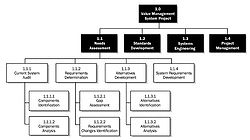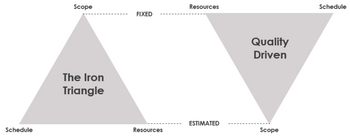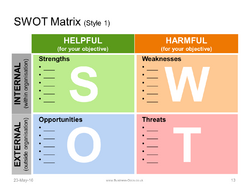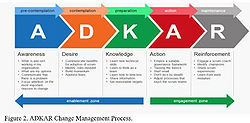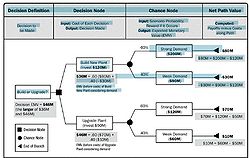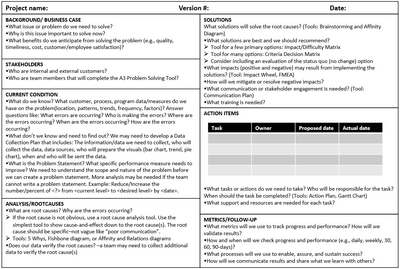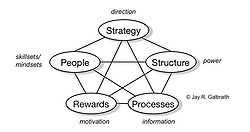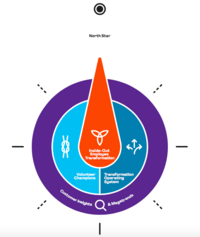DS Solution
(→HOUSE OF QUALITY) |
(→Benefits Realisation Management (BRM)) |
||
| (140 intermediate revisions by 6 users not shown) | |||
| Line 1: | Line 1: | ||
| − | + | The following tools are divided into four categories: Purpose, People, Complexity and Uncertainty. | |
| + | The first one includes the tools used to complete the project successfully. | ||
| + | The second includes the tools due to identify and manage all the people involve in the project. | ||
| + | The third one involves the tools due to analyze the project and its stages. | ||
| + | The last one include the tools used to manage risk and change in the project. | ||
| − | = | + | =Purpose= |
| + | ==BUSINESS CASE== | ||
| + | A business case <ref name="name">''https://mosaicprojects.com.au/WhitePapers/WP1018_Business_Case.pdf' </ref> is a document which containts crucial information about the project. It explores all feasible approaches to a given problem to enable the business owners or decision makers to select the option that best serves the organisation. A well structured Business Case describes the business problem / opportunity to be addressed by the proposed project (or program), the motivations driving the project, and the alternative solutions available. | ||
| + | When approved, the Business Case becomes the foundation for the project (or programme) as it fully documents the reasons for creating the project, the key benefits to be delivered and the associated risks, assumptions and constraints. To create a business case you should: | ||
| + | #Identify the Business Problem or opportunity: it describes what the “need” is; | ||
| + | #Define how the project supports the Organisation’s Strategic Objectives; | ||
| + | #Identify the Alternative Solutions and assess them | ||
| + | #Recommend a Preferred Solution | ||
| + | #Calculate the Return on Investment (ROI) for the preferred option | ||
| + | #Describe the Implementation Approach | ||
| + | #Obtain Agreement from the Project Sponsors, PMO or other authority | ||
| − | == | + | ==S.M.A.R.T== |
| − | + | [[FILE:SMART DS.JPG|right|250px|thumb|]] | |
| − | |||
| − | + | The S:M:A:R:T<ref name=''name''> ''https://hr.wayne.edu/leads/phase1/smart-objectives | |
| − | + | https://www.mindtools.com/pages/article/smart-goals.htm | |
| − | + | https://www.motiviertproduktiv.de/smart-ziele-formulieren-beispiele/ | |
| − | + | '' </ref> is used to achieve goals, they must be formulated so that each employee understands them correctly. | |
| − | The | + | There should be no room for misinterpretation. Because of that goals must be formulated “smart”. |
| + | The term is an abbreviation of the American, and the letters "S.M.A.R.T." stand for: "specific, measurable, achievable, relevant and time-based". | ||
| − | + | Specific (simple, sensible, significant). | |
| + | #What do I want to accomplish? | ||
| + | #Why is this goal important? | ||
| + | #Who is involved? | ||
| + | #Where is it located? | ||
| + | #Which resources or limits are involved? | ||
| − | == | + | Measurable (meaningful, motivating). |
| − | + | #How much? | |
| + | #How many? | ||
| + | #How will I know when it is accomplished? | ||
| + | |||
| + | Achievable (agreed, attainable). | ||
| + | #How can I accomplish this goal? | ||
| + | #How realistic is the goal, based on other constraints, such as financial factors? | ||
| + | |||
| + | Relevant (reasonable, realistic and resourced, results-based). | ||
| + | #Does this seem worthwhile? | ||
| + | #Is this the right time? | ||
| + | #Does this match our other efforts/needs? | ||
| + | #Am I the right person to reach this goal? | ||
| + | #Is it applicable in the current socio-economic environment? | ||
| + | |||
| + | Time-based (time-based, time limited, time/cost limited, timely, time-sensitive). | ||
| + | #When? | ||
| + | #What can I do six months from now? | ||
| + | #What can I do six weeks from now? | ||
| + | #What can I do today? | ||
| + | |||
| + | With the help of this tool it is possible for us to formulate goals properly, to share them in an understanding manner and to monitor the progress quickly. | ||
| + | |||
| + | =People= | ||
| + | |||
| + | ==MAPPING BENEFITS FOR STAKEHOLDERS== | ||
| + | [[File:Stake.png|right|250px|thumb|]] | ||
| + | In a project, established the business case, the next stage includes exploring possible benefits for the stakeholders<ref name=''name''> ''https://c4cm.co.uk/CourseMaterial/BensMgt/Benefits%20Management%20material.pdf'' </ref>. In particular, it’s needed to analyze the value they will get from the project and, secondly, how they will be affected by the change. | ||
| + | Consequently, the first procedure is to identify and map several benefits. These benefits have to be prioritized and this is possible by mapping the benefits onto the relevant stakeholders. A low priority stakeholder is connected with a low priority benefit, and the same about the high priority. | ||
| + | To do this it’s used a matrix: on the top there are all the stakeholders considered, ordered for importance, from left to right; in each row there are the activities due to the project. | ||
| + | |||
| + | ==STAKEHOLDER ANALASYS== | ||
| + | |||
| + | The aim of the stakeholder analysis (also environment analysis or force field analysis) is to [[File:Stakeholdergrid1new.jpg|right|250px|thumb|Figure 10: <ref name=''name''> ''https://www.mindtools.com/media/Diagrams/stakeholdergrid1new.jpg'' </ref>]] | ||
| + | recognize which internal and external people could influence the project and to work on it. | ||
| + | In addition, these people and groups are categorized and evaluated with regard to their | ||
| + | values and influences as well as ideas. <ref name=''name''> ''https://www.mindtools.com/pages/article/newPPM_07.htm'' </ref> | ||
| + | Stakeholder analysis typically involves the following four steps. | ||
| + | #Identifying: Listing the individuals or groups that can be affected by and/or affect the change program. | ||
| + | #Analyzing: Formulating an understanding of the stakeholders, regarding their point of view, ambitions, power etc. | ||
| + | #Mapping: Visualizing the results of the previous step. | ||
| + | #Prioritizing: Ranking the relevance/importance of stakeholders in order to decide with which to engage. | ||
| + | |||
| + | |||
| + | Based on the results of the stakeholder analysis, we as a project team know how and why the respective stakeholders act the way they do and what we can do about possibly negative stakeholders to make them positive. | ||
| + | <ref name=''name''> ''http://wiki.doing-projects.org/index.php/Stakeholder_Management_in_Change_Programs'' </ref> | ||
==HOUSE OF QUALITY== | ==HOUSE OF QUALITY== | ||
| − | + | [[File:HOUSE-OF-QUALITY.png|right|250px|thumb|]] | |
| + | The ''Quality Functional Deployment''write <ref name=''name''> ''Gestione dei progetti di innovazione, Alessandro Grandi, Mcgraw Hill Education, 2017'' </ref>is a complex process divided into three steps, with the aim of find out the specific costumer’s requests. Their preferences, collected in the first and second step, are reported in a diagram, called the '''House of Quality'''. | ||
| + | It’s built in ten different moments: | ||
| + | #List of costumers’ needs | ||
| + | #Index of importance according to costumers’ needs | ||
| + | #Translation od costumers’ needs into technical specifications | ||
| + | #Units of measurement of technical specifications | ||
| + | #Correlation matrix | ||
| + | #Relation matrix | ||
| + | #Relative importance of technical specifications | ||
| + | #Comparison with competitor’s products | ||
| + | #Technical benchmark | ||
| + | #Analysis of organizational difficulties | ||
| + | This modular tool ensure full coherence between the design of the product and its production, reducing the corrections during the development of the project. | ||
| + | The requests without a formal response in quantified attributes appear as an empty column or an empty line in the diagram. | ||
| + | |||
| + | ==INTERVIEWS== | ||
| + | |||
===Defenition=== | ===Defenition=== | ||
| − | + | An interview is a formal or informal approach to elicit information from stakeholders by talking to them directly. It is typically performed by asking prepared and spontaneous questions and recording the responses. Interviews are often conducted on an individual basis between an interviewer and an interviewee, but may involve multiple interviewers and/or multiple interviewees. | |
| + | |||
===Benefits=== | ===Benefits=== | ||
| − | === | + | Interviewing experienced project participants, sponsors, other executives, and subject matter experts can aid in identifying and defining the features and functions of the desired product deliverables. Interviews are also useful for obtaining confidential information, assumption and constraint analysis. |
| − | === | + | |
| − | === | + | =Complexity= |
| + | |||
| + | ==Benefits Realisation Management (BRM)== | ||
| + | '''Benefits Realisation Management or BRM''' <ref name=''name''> ''Benefits Realisation Management (BRM)'' - http://wiki.doing-projects.org/index.php/Benefits_Realisation_Management_(BRM) </ref> is a method used in management to define and measure the value that a project, program or portfolio management will bring into a company. | ||
| + | The benefits realisation management purpose is to identify the benefits that the organisation is going to acquire. Moreover, the BRM aligns the benefits with the interest and the vision statement of the company and it, also, strongly increases the possibility that they will be gained. Indeed, one of the key points of the benefits realisation management is not only to define the benefits but as well to decrease the possible risks related to these benefits. | ||
| + | The BRM method can be decomposed in three different steps: '''identify benefits, execute benefits and sustain benefits.''' | ||
| + | [[File:BRM.jpg|right|500px|thumb|]] | ||
| + | |||
| + | ===Identify Benefits=== | ||
| + | The purpose of this first step, previously outlined, is to comprehend if the benefits are aligned with the business plan of the company, in order to bring value to it. | ||
| + | |||
| + | Besides, a diligent analysis, of the individualised benefits, will improve their further managing. In order to pursue the right benefits a deeply understanding of the business case of the organisation is necessary. | ||
| + | As more information arises, it is also important to define the possible positive and negative risk related to the identified benefits. To give examples of these risks, they may be the disagreement from the stakeholders, unexpected outcomes or change in program activities. | ||
| + | In this phase '''KPIs''' are useful to help the manager to understand the actual situation and to compare these result with the planned ones. | ||
| + | Different tools can be used to quantify, plan and give a profile to these benefits such as: '''benefits register, benefits map or a benefit profile.''' | ||
| + | |||
| + | ===Execute Benefits=== | ||
| + | In the "''Execute Benefits''" part of the methods, the manager will guarantee the '''minimum risk''' for each previously outlined benefit and, in addition, he will focus on the discovery of possible new benefits that may be gained. | ||
| + | |||
| + | One of the first step, on this stage of the Benefits Realisation Management, is to confirm that the stakeholders have deeply comprehended the positive outcomes of the program and how these benefits are going to affect in a positive way the business. | ||
| + | |||
| + | This ensures that when the benefits will have been delivered they will see them as a gained value. | ||
| + | Moreover, the stakeholders must be informed about the progress and deliveries of these benefits. | ||
| + | |||
| + | The process between the benefits analysis and planning and their delivery is not a linear process. | ||
| + | Indeed it is most of the time an '''iterative process''', in which corrective action is continuously necessary as the planned conditions change. | ||
| + | |||
| + | The progress of the benefits has to be continuously reviewed to realise if some change, in the program activities, may be needed, in order to move the positive outcomes closer to the original expectation. This progress can be monitored using the previously defined measures and key indicators. | ||
| + | It is also fundamental seeking the opportunity for new benefits to be implemented in the program benefits list as the program advance or a change occur. Indeed during the program evolution, new opportunities may arise and are important to be proactive and ready to gain a positive outcome. | ||
| + | |||
| + | ===Sustain Benefits=== | ||
| + | The last part of the Benefits Realisation Management ensures that it will still be adding value to the organisation, even beyond the program end. | ||
| + | In point of fact is necessary, even when a program is closed, its positive outcomes are sustained and managed to keep their principal scope. | ||
| + | |||
| + | First of all, the benefits sustainment ought to be considered prior to the end of the program. | ||
| + | |||
| + | More specifically, a '''benefits sustainment plan''' should be created before the end of the program, and it should include all the risks, the measures and the tools to guarantee that the delivered benefits will be continuing generating value. | ||
| + | |||
| + | The importance of a quality sustainment plan lies on the fact that after an end of a program the management of the benefits passes to others. | ||
| + | Moreover, once the program finishes is critical to effectuate a '''post-program evaluation''' to have important and useful information for the future. | ||
| + | Some of the activities that may help the sustainment of the benefits are: | ||
| + | |||
| + | -'''Implementing''' the right changes to make sure, even though the resources used for the program will be back to the organisation, the positive outcomes performance will be monitored. | ||
| + | |||
| + | -'''Monitoring''' the risk defined in the sustainment plan for the delivered benefits and implement the right changes if needed. | ||
| − | |||
| − | |||
| − | |||
| − | |||
| − | |||
| − | |||
==WBS== | ==WBS== | ||
| − | + | [[File:WBS-illustration-only.jpg|right|250px|thumb|]]The '''WBS (Work Breakdown Structure)''' <ref name=''7''> ''Project Management Institute, Inc.. (2017). Guide to the Project Management Body of Knowledge (PMBOK® Guide) (6th Edition) - 5.4.1.4 Organizational Process Assets. (pp. 156-157). Project Management Institute, Inc. (PMI). Retrieved from https://app.knovel.com/hotlink/pdf/id:kt011DX6D4/guide-project-management/create-wbs-organizational'' </ref> is a hierarchical decomposition of the total scope of work to be carried out by the project team to accomplish the project objectives and create the required deliverables. Each descending level of the WBS represents an increasingly detailed definition of the project work. The lowest level of the WBS is formed by the '''work packages''' with a unique identifier, which can be used to group the activities where work is scheduled and estimated, monitored, and controlled. | |
| + | |||
| + | ===Create WBS=== | ||
| + | Decomposition is a technique used for dividing and subdividing the project scope and project deliverables into smaller, more manageable parts. The level of decomposition is related to the degree of control needed to effectively manage the project. The level of detail for work packages depends on the size and complexity of the project. A WBS structure may be created through various approaches. Some of the popular methods include the top-down approach, the use of organization-specific guidelines, and the use of WBS templates. A bottom-up approach can be used to group subcomponent. | ||
| + | |||
==THE IRON TRIANGLE== | ==THE IRON TRIANGLE== | ||
| − | + | '''The Project Management Triangle''' <ref name=''name''> ''What is Iron Triangle of Projects?, retreived from https://www.visual-paradigm.com/project-management/what-is-iron-triangle-of-projects/, 2020-02-25'' </ref> [[File:TriangleDS.png|right|350px|thumb|]]is a tool that gives a model of the restrictions of project management. Is very important for the success of a project to handle the different situations, in a way to maintain stability with the different factors that constrain the overall project delivery. These factors are: Scope, Schedule and Cost. Scope allude of all the actions, performances and works involved in the project, Schedule is the estimated time for the project delivery and Cost are all the resources necessaries to deliver the work. In this way, the manner of dealing and controlling these three factors with their constraints is going to determine the quality of the work, and if one of these constraints changes, then is going to be necessary to change another one to keep the same initial quality. | |
| + | |||
| + | Now, if we compare the Traditional triangle with the agile one, there are some few differences. In the traditional one, there is a fixed scope of product requirements, which implies that is necessary to be a little flexible with the resources and schedule. In the other hand, the Agile triangle has a fixed schedule and resources, which means that the scope needs to be a little flexible. | ||
| + | |||
| + | In the next figure you can see the Traditional triangle on the left and the Agile triangle on the right: | ||
| + | |||
| + | =Uncertainty= | ||
| + | ==SWOT Analysis== | ||
| + | [[File:swwot.png|right|250px|thumb|]] | ||
| + | ===Defenition=== | ||
| + | |||
| + | '''SWOT Analysis''' <ref name=''name''> ''Gareth R. Jones and Jennifer M. George, ''Essentials of Contemporary Management'', Eighth Edition, page 198, McGraw-Hill Education, 2019, ISBN 9781259927652'' </ref> is a planning exercise in which managers identify ''internal'' organizational strengths (S) and weaknesses (W) and ''external'' environmental opportunities (O) and threats (T), using the popular 2x2 matrix. | ||
| + | |||
| + | ===Practical guidelines=== | ||
| + | The first step in SWOT analysis is to identify an organization’s strengths (such as high-quality skills in marketing and in research and development) and weaknesses (such as rising manufacturing costs and outdated technology). The task facing managers is to identify the strengths and weaknesses that characterize the present state of their organization. | ||
| + | |||
| + | The second step in SWOT analysis begins when managers embark on a full-scale SWOT planning exercise to identify potential opportunities and threats in the environment that affect the organization now or may affect it in the future. | ||
| + | After applying a SWOT analysis on a business project, decision-makers should understand if the goal is attainable or not. In case that the goal is not achievable, decision-makers must select another goal and repeat all the process again. | ||
| + | |||
| + | ==ADKAR== | ||
| + | [[File:adkar.jpg|500px|right|250px|thumb|]] | ||
| + | '''The ADKAR model''' <ref name=''name''> ''The Prosci ADKAR Model: Why it Works - https://www.prosci.com/resources/articles/why-the-adkar-model-works'' </ref> is a 5-step framework that helps deal with the people-aspect of change management. | ||
| + | ADKAR is an acronym that represents the five milestones or outcomes an individual must achieve for change to be successfully realized: ''awareness'' (of the need to change), ''desire'' (to participate and support the change), ''knowledge'' (about how to change), ''ability'' (to implement new skills and behaviors) and ''reinforcement'' (to keep the change in place). | ||
| + | |||
| + | When applied to organizational change, this model allows leaders and change management teams to focus their activities on what will collectively drive individual change and produce organizational results. | ||
| + | The ADKAR Model will highlight the areas where you can take focused, corrective action to improve change success. | ||
| + | |||
| + | |||
| + | |||
| + | ==DECISION TREE ANALASYS== | ||
| + | [[File:DT.JPG|right|250px|thumb|]] | ||
| + | |||
| + | |||
| + | ===Defenition=== | ||
| + | Decision trees<ref name=''name''> ''https://en.wikipedia.org/wiki/Decision_tree'' </ref> are used to support selection of the best of several alternative courses of | ||
| + | action. Alternative paths through the project are shown in the decision tree using branches representing different | ||
| + | decisions or events, each of which can have associated costs and related individual project risks (including both | ||
| + | threats and opportunities). The end-points of branches in the decision tree represent the outcome from following | ||
| + | that particular path, which can be negative or positive. | ||
| + | |||
| + | ===practical guidelines=== | ||
| + | Decision trees are commonly used in operations research and operations management. If, in practice, decisions have to be taken online with no recall under incomplete knowledge, a decision tree should be paralleled by a probability model as a best choice model or online selection model algorithm. Another use of decision trees is as a descriptive means for calculating conditional probabilities. | ||
| + | |||
| + | |||
| + | |||
| + | ==A3 REPORT== | ||
| + | [[File:A3DS.png|right|400px|thumb|]] | ||
| + | '''The A3''' <ref name=''name''> ''A3 Process and Problem Solving, retreived from https://leankit.com/learn/lean/a3-process-and-problem-solving/, 2020-02-25'' </ref> process is a Lean thinking tool, which helps teams to have a continuous improvement through problem solving, reporting project status and proposing policy changes. In the same way, this tool is a method to cooperate in a strategically way to reach the purpose and goals of the team or organization. In this way, the A3 tool is going to help the team/organization ensuring standardization (process is used consistently through every member), collaboration (bridge the gaps between teams), visibility (for improvement), impact (determine the quantitative and qualitative results) and knowledge transfer (available to all employees at any time). | ||
| + | It is possible to recognize in the A3 process two big parts: Identify the problem and Implement the solution, where each part has different steps. | ||
| + | |||
| + | To identify the problem is necessary to find out: | ||
| + | #The issue that is needed to solve. | ||
| + | #Stakeholders. | ||
| + | #Current situation. | ||
| + | #Root cause analysis. | ||
| + | |||
| + | On the other hand, to implement a solution is necessary to find out: | ||
| + | #What solutions solve the root causes and which are their impacts. | ||
| + | #Develop a plan of implementation with every member on board. | ||
| + | #Finally follow-up and evaluate results. | ||
| + | |||
| + | |||
| + | |||
==STAR MODEL== | ==STAR MODEL== | ||
| − | + | The '''Star Model'''<ref name=''name''> ''https://www.jaygalbraith.com/images/pdfs/StarModel.pdf'' </ref>framework for organization design is the foundation on which a company bases its design choices. The framework consists of a series of design policies that are controllable by management and can influence employee behavior. [[File:the-star-model.jpg|right|250px|thumb|]] | |
| − | == | + | The Star Model has 5 categories: |
| − | + | # ''Strategy'', it specifies the goals and objectives to be achieved by the company; | |
| − | == | + | # ''Structure'', it determines how the power is distributed; |
| − | + | # ''Processes'', it represents how the information and decisions flow into the organization; | |
| + | # ''Rewards'', its purpose is to align the organization's goals with the employee's goals; | ||
| + | # ''People'', it produces the talent required by the strategy and structure of the organization; | ||
| + | ===Implication=== | ||
| + | Although the structure is usually overemphasized because many people believe that it affects status and power, the ''Structure'' in the Star Model is only one facet. Another important feature in the Star Model is that different strategies lead to different organizations. This means that there is no one-size-fits-all organization design. The third implication is that for an organization to be effective, all the policies must be aligned and interacting harmoniously with one another. | ||
| + | |||
| + | |||
| + | |||
| + | ==BRIGHTLINE TRANSFORMATION COMPASS== | ||
| + | The '''Brightline Transformation Compass''' <ref name=''name''> ''The Brightline Transformation Compass: a compensive system for transformation https://brightline-website.s3-us-east-2.amazonaws.com/downloads/compass/The_Brightline_Transformation_Compass.pdf?utm_source=website&utm_medium=skip-link'' </ref> [[File:BRIGHTLINE-TRANSFORMATION.png|right|200px|thumb|]] | ||
| + | is a successful method to implement in a company, in order to transform the mind-set of the employees and thus the culture of the organization. The concept of a compass, on which this theory is based, consists of five main blocks of transformation: | ||
| + | #''The North Star'': motivate the employees through a strategic vision | ||
| + | #''Costumer Insights & Megatrends'': choose some needs as a target to start an intern and external analysis (studying deeply the ecosystem of competitors) | ||
| + | #''Transformation Operating System'': the structure of an organization must fit the pace and the targets of the effort. | ||
| + | #''Your Volunteer Champions'': all the employees who are willing to drive the strategy forward while continuing to deliver in their day to day jobs. | ||
| + | #''Inside-out Employees Transformation'': each employee must focus on his personal skills. | ||
| + | |||
| + | =References= | ||
| + | |||
| + | <references /> | ||
Latest revision as of 10:47, 9 March 2020
The following tools are divided into four categories: Purpose, People, Complexity and Uncertainty. The first one includes the tools used to complete the project successfully. The second includes the tools due to identify and manage all the people involve in the project. The third one involves the tools due to analyze the project and its stages. The last one include the tools used to manage risk and change in the project.
Contents |
[edit] Purpose
[edit] BUSINESS CASE
A business case [1] is a document which containts crucial information about the project. It explores all feasible approaches to a given problem to enable the business owners or decision makers to select the option that best serves the organisation. A well structured Business Case describes the business problem / opportunity to be addressed by the proposed project (or program), the motivations driving the project, and the alternative solutions available. When approved, the Business Case becomes the foundation for the project (or programme) as it fully documents the reasons for creating the project, the key benefits to be delivered and the associated risks, assumptions and constraints. To create a business case you should:
- Identify the Business Problem or opportunity: it describes what the “need” is;
- Define how the project supports the Organisation’s Strategic Objectives;
- Identify the Alternative Solutions and assess them
- Recommend a Preferred Solution
- Calculate the Return on Investment (ROI) for the preferred option
- Describe the Implementation Approach
- Obtain Agreement from the Project Sponsors, PMO or other authority
[edit] S.M.A.R.T
The S:M:A:R:T[2] is used to achieve goals, they must be formulated so that each employee understands them correctly.
There should be no room for misinterpretation. Because of that goals must be formulated “smart”.
The term is an abbreviation of the American, and the letters "S.M.A.R.T." stand for: "specific, measurable, achievable, relevant and time-based".
Specific (simple, sensible, significant).
- What do I want to accomplish?
- Why is this goal important?
- Who is involved?
- Where is it located?
- Which resources or limits are involved?
Measurable (meaningful, motivating).
- How much?
- How many?
- How will I know when it is accomplished?
Achievable (agreed, attainable).
- How can I accomplish this goal?
- How realistic is the goal, based on other constraints, such as financial factors?
Relevant (reasonable, realistic and resourced, results-based).
- Does this seem worthwhile?
- Is this the right time?
- Does this match our other efforts/needs?
- Am I the right person to reach this goal?
- Is it applicable in the current socio-economic environment?
Time-based (time-based, time limited, time/cost limited, timely, time-sensitive).
- When?
- What can I do six months from now?
- What can I do six weeks from now?
- What can I do today?
With the help of this tool it is possible for us to formulate goals properly, to share them in an understanding manner and to monitor the progress quickly.
[edit] People
[edit] MAPPING BENEFITS FOR STAKEHOLDERS
In a project, established the business case, the next stage includes exploring possible benefits for the stakeholders[3]. In particular, it’s needed to analyze the value they will get from the project and, secondly, how they will be affected by the change. Consequently, the first procedure is to identify and map several benefits. These benefits have to be prioritized and this is possible by mapping the benefits onto the relevant stakeholders. A low priority stakeholder is connected with a low priority benefit, and the same about the high priority. To do this it’s used a matrix: on the top there are all the stakeholders considered, ordered for importance, from left to right; in each row there are the activities due to the project.
[edit] STAKEHOLDER ANALASYS
The aim of the stakeholder analysis (also environment analysis or force field analysis) is to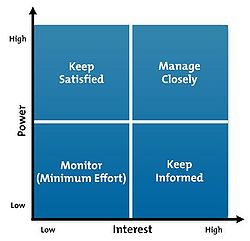
recognize which internal and external people could influence the project and to work on it. In addition, these people and groups are categorized and evaluated with regard to their values and influences as well as ideas. [5] Stakeholder analysis typically involves the following four steps.
- Identifying: Listing the individuals or groups that can be affected by and/or affect the change program.
- Analyzing: Formulating an understanding of the stakeholders, regarding their point of view, ambitions, power etc.
- Mapping: Visualizing the results of the previous step.
- Prioritizing: Ranking the relevance/importance of stakeholders in order to decide with which to engage.
Based on the results of the stakeholder analysis, we as a project team know how and why the respective stakeholders act the way they do and what we can do about possibly negative stakeholders to make them positive.
[6]
[edit] HOUSE OF QUALITY
The Quality Functional Deploymentwrite [7]is a complex process divided into three steps, with the aim of find out the specific costumer’s requests. Their preferences, collected in the first and second step, are reported in a diagram, called the House of Quality. It’s built in ten different moments:
- List of costumers’ needs
- Index of importance according to costumers’ needs
- Translation od costumers’ needs into technical specifications
- Units of measurement of technical specifications
- Correlation matrix
- Relation matrix
- Relative importance of technical specifications
- Comparison with competitor’s products
- Technical benchmark
- Analysis of organizational difficulties
This modular tool ensure full coherence between the design of the product and its production, reducing the corrections during the development of the project. The requests without a formal response in quantified attributes appear as an empty column or an empty line in the diagram.
[edit] INTERVIEWS
[edit] Defenition
An interview is a formal or informal approach to elicit information from stakeholders by talking to them directly. It is typically performed by asking prepared and spontaneous questions and recording the responses. Interviews are often conducted on an individual basis between an interviewer and an interviewee, but may involve multiple interviewers and/or multiple interviewees.
[edit] Benefits
Interviewing experienced project participants, sponsors, other executives, and subject matter experts can aid in identifying and defining the features and functions of the desired product deliverables. Interviews are also useful for obtaining confidential information, assumption and constraint analysis.
[edit] Complexity
[edit] Benefits Realisation Management (BRM)
Benefits Realisation Management or BRM [8] is a method used in management to define and measure the value that a project, program or portfolio management will bring into a company. The benefits realisation management purpose is to identify the benefits that the organisation is going to acquire. Moreover, the BRM aligns the benefits with the interest and the vision statement of the company and it, also, strongly increases the possibility that they will be gained. Indeed, one of the key points of the benefits realisation management is not only to define the benefits but as well to decrease the possible risks related to these benefits. The BRM method can be decomposed in three different steps: identify benefits, execute benefits and sustain benefits.
[edit] Identify Benefits
The purpose of this first step, previously outlined, is to comprehend if the benefits are aligned with the business plan of the company, in order to bring value to it.
Besides, a diligent analysis, of the individualised benefits, will improve their further managing. In order to pursue the right benefits a deeply understanding of the business case of the organisation is necessary. As more information arises, it is also important to define the possible positive and negative risk related to the identified benefits. To give examples of these risks, they may be the disagreement from the stakeholders, unexpected outcomes or change in program activities. In this phase KPIs are useful to help the manager to understand the actual situation and to compare these result with the planned ones. Different tools can be used to quantify, plan and give a profile to these benefits such as: benefits register, benefits map or a benefit profile.
[edit] Execute Benefits
In the "Execute Benefits" part of the methods, the manager will guarantee the minimum risk for each previously outlined benefit and, in addition, he will focus on the discovery of possible new benefits that may be gained.
One of the first step, on this stage of the Benefits Realisation Management, is to confirm that the stakeholders have deeply comprehended the positive outcomes of the program and how these benefits are going to affect in a positive way the business.
This ensures that when the benefits will have been delivered they will see them as a gained value. Moreover, the stakeholders must be informed about the progress and deliveries of these benefits.
The process between the benefits analysis and planning and their delivery is not a linear process. Indeed it is most of the time an iterative process, in which corrective action is continuously necessary as the planned conditions change.
The progress of the benefits has to be continuously reviewed to realise if some change, in the program activities, may be needed, in order to move the positive outcomes closer to the original expectation. This progress can be monitored using the previously defined measures and key indicators. It is also fundamental seeking the opportunity for new benefits to be implemented in the program benefits list as the program advance or a change occur. Indeed during the program evolution, new opportunities may arise and are important to be proactive and ready to gain a positive outcome.
[edit] Sustain Benefits
The last part of the Benefits Realisation Management ensures that it will still be adding value to the organisation, even beyond the program end. In point of fact is necessary, even when a program is closed, its positive outcomes are sustained and managed to keep their principal scope.
First of all, the benefits sustainment ought to be considered prior to the end of the program.
More specifically, a benefits sustainment plan should be created before the end of the program, and it should include all the risks, the measures and the tools to guarantee that the delivered benefits will be continuing generating value.
The importance of a quality sustainment plan lies on the fact that after an end of a program the management of the benefits passes to others. Moreover, once the program finishes is critical to effectuate a post-program evaluation to have important and useful information for the future. Some of the activities that may help the sustainment of the benefits are:
-Implementing the right changes to make sure, even though the resources used for the program will be back to the organisation, the positive outcomes performance will be monitored.
-Monitoring the risk defined in the sustainment plan for the delivered benefits and implement the right changes if needed.
[edit] WBS
The WBS (Work Breakdown Structure) [9] is a hierarchical decomposition of the total scope of work to be carried out by the project team to accomplish the project objectives and create the required deliverables. Each descending level of the WBS represents an increasingly detailed definition of the project work. The lowest level of the WBS is formed by the work packages with a unique identifier, which can be used to group the activities where work is scheduled and estimated, monitored, and controlled.[edit] Create WBS
Decomposition is a technique used for dividing and subdividing the project scope and project deliverables into smaller, more manageable parts. The level of decomposition is related to the degree of control needed to effectively manage the project. The level of detail for work packages depends on the size and complexity of the project. A WBS structure may be created through various approaches. Some of the popular methods include the top-down approach, the use of organization-specific guidelines, and the use of WBS templates. A bottom-up approach can be used to group subcomponent.
[edit] THE IRON TRIANGLE
The Project Management Triangle [10] is a tool that gives a model of the restrictions of project management. Is very important for the success of a project to handle the different situations, in a way to maintain stability with the different factors that constrain the overall project delivery. These factors are: Scope, Schedule and Cost. Scope allude of all the actions, performances and works involved in the project, Schedule is the estimated time for the project delivery and Cost are all the resources necessaries to deliver the work. In this way, the manner of dealing and controlling these three factors with their constraints is going to determine the quality of the work, and if one of these constraints changes, then is going to be necessary to change another one to keep the same initial quality.Now, if we compare the Traditional triangle with the agile one, there are some few differences. In the traditional one, there is a fixed scope of product requirements, which implies that is necessary to be a little flexible with the resources and schedule. In the other hand, the Agile triangle has a fixed schedule and resources, which means that the scope needs to be a little flexible.
In the next figure you can see the Traditional triangle on the left and the Agile triangle on the right:
[edit] Uncertainty
[edit] SWOT Analysis
[edit] Defenition
SWOT Analysis [11] is a planning exercise in which managers identify internal organizational strengths (S) and weaknesses (W) and external environmental opportunities (O) and threats (T), using the popular 2x2 matrix.
[edit] Practical guidelines
The first step in SWOT analysis is to identify an organization’s strengths (such as high-quality skills in marketing and in research and development) and weaknesses (such as rising manufacturing costs and outdated technology). The task facing managers is to identify the strengths and weaknesses that characterize the present state of their organization.
The second step in SWOT analysis begins when managers embark on a full-scale SWOT planning exercise to identify potential opportunities and threats in the environment that affect the organization now or may affect it in the future. After applying a SWOT analysis on a business project, decision-makers should understand if the goal is attainable or not. In case that the goal is not achievable, decision-makers must select another goal and repeat all the process again.
[edit] ADKAR
The ADKAR model [12] is a 5-step framework that helps deal with the people-aspect of change management. ADKAR is an acronym that represents the five milestones or outcomes an individual must achieve for change to be successfully realized: awareness (of the need to change), desire (to participate and support the change), knowledge (about how to change), ability (to implement new skills and behaviors) and reinforcement (to keep the change in place).
When applied to organizational change, this model allows leaders and change management teams to focus their activities on what will collectively drive individual change and produce organizational results. The ADKAR Model will highlight the areas where you can take focused, corrective action to improve change success.
[edit] DECISION TREE ANALASYS
[edit] Defenition
Decision trees[13] are used to support selection of the best of several alternative courses of action. Alternative paths through the project are shown in the decision tree using branches representing different decisions or events, each of which can have associated costs and related individual project risks (including both threats and opportunities). The end-points of branches in the decision tree represent the outcome from following that particular path, which can be negative or positive.
[edit] practical guidelines
Decision trees are commonly used in operations research and operations management. If, in practice, decisions have to be taken online with no recall under incomplete knowledge, a decision tree should be paralleled by a probability model as a best choice model or online selection model algorithm. Another use of decision trees is as a descriptive means for calculating conditional probabilities.
[edit] A3 REPORT
The A3 [14] process is a Lean thinking tool, which helps teams to have a continuous improvement through problem solving, reporting project status and proposing policy changes. In the same way, this tool is a method to cooperate in a strategically way to reach the purpose and goals of the team or organization. In this way, the A3 tool is going to help the team/organization ensuring standardization (process is used consistently through every member), collaboration (bridge the gaps between teams), visibility (for improvement), impact (determine the quantitative and qualitative results) and knowledge transfer (available to all employees at any time). It is possible to recognize in the A3 process two big parts: Identify the problem and Implement the solution, where each part has different steps.
To identify the problem is necessary to find out:
- The issue that is needed to solve.
- Stakeholders.
- Current situation.
- Root cause analysis.
On the other hand, to implement a solution is necessary to find out:
- What solutions solve the root causes and which are their impacts.
- Develop a plan of implementation with every member on board.
- Finally follow-up and evaluate results.
[edit] STAR MODEL
The Star Model[15]framework for organization design is the foundation on which a company bases its design choices. The framework consists of a series of design policies that are controllable by management and can influence employee behavior.The Star Model has 5 categories:
- Strategy, it specifies the goals and objectives to be achieved by the company;
- Structure, it determines how the power is distributed;
- Processes, it represents how the information and decisions flow into the organization;
- Rewards, its purpose is to align the organization's goals with the employee's goals;
- People, it produces the talent required by the strategy and structure of the organization;
[edit] Implication
Although the structure is usually overemphasized because many people believe that it affects status and power, the Structure in the Star Model is only one facet. Another important feature in the Star Model is that different strategies lead to different organizations. This means that there is no one-size-fits-all organization design. The third implication is that for an organization to be effective, all the policies must be aligned and interacting harmoniously with one another.
[edit] BRIGHTLINE TRANSFORMATION COMPASS
The Brightline Transformation Compass [16]is a successful method to implement in a company, in order to transform the mind-set of the employees and thus the culture of the organization. The concept of a compass, on which this theory is based, consists of five main blocks of transformation:
- The North Star: motivate the employees through a strategic vision
- Costumer Insights & Megatrends: choose some needs as a target to start an intern and external analysis (studying deeply the ecosystem of competitors)
- Transformation Operating System: the structure of an organization must fit the pace and the targets of the effort.
- Your Volunteer Champions: all the employees who are willing to drive the strategy forward while continuing to deliver in their day to day jobs.
- Inside-out Employees Transformation: each employee must focus on his personal skills.
[edit] References
- ↑ https://mosaicprojects.com.au/WhitePapers/WP1018_Business_Case.pdf'
- ↑ https://hr.wayne.edu/leads/phase1/smart-objectives https://www.mindtools.com/pages/article/smart-goals.htm https://www.motiviertproduktiv.de/smart-ziele-formulieren-beispiele/
- ↑ https://c4cm.co.uk/CourseMaterial/BensMgt/Benefits%20Management%20material.pdf
- ↑ https://www.mindtools.com/media/Diagrams/stakeholdergrid1new.jpg
- ↑ https://www.mindtools.com/pages/article/newPPM_07.htm
- ↑ http://wiki.doing-projects.org/index.php/Stakeholder_Management_in_Change_Programs
- ↑ Gestione dei progetti di innovazione, Alessandro Grandi, Mcgraw Hill Education, 2017
- ↑ Benefits Realisation Management (BRM) - http://wiki.doing-projects.org/index.php/Benefits_Realisation_Management_(BRM)
- ↑ Project Management Institute, Inc.. (2017). Guide to the Project Management Body of Knowledge (PMBOK® Guide) (6th Edition) - 5.4.1.4 Organizational Process Assets. (pp. 156-157). Project Management Institute, Inc. (PMI). Retrieved from https://app.knovel.com/hotlink/pdf/id:kt011DX6D4/guide-project-management/create-wbs-organizational
- ↑ What is Iron Triangle of Projects?, retreived from https://www.visual-paradigm.com/project-management/what-is-iron-triangle-of-projects/, 2020-02-25
- ↑ Gareth R. Jones and Jennifer M. George, Essentials of Contemporary Management, Eighth Edition, page 198, McGraw-Hill Education, 2019, ISBN 9781259927652
- ↑ The Prosci ADKAR Model: Why it Works - https://www.prosci.com/resources/articles/why-the-adkar-model-works
- ↑ https://en.wikipedia.org/wiki/Decision_tree
- ↑ A3 Process and Problem Solving, retreived from https://leankit.com/learn/lean/a3-process-and-problem-solving/, 2020-02-25
- ↑ https://www.jaygalbraith.com/images/pdfs/StarModel.pdf
- ↑ The Brightline Transformation Compass: a compensive system for transformation https://brightline-website.s3-us-east-2.amazonaws.com/downloads/compass/The_Brightline_Transformation_Compass.pdf?utm_source=website&utm_medium=skip-link
